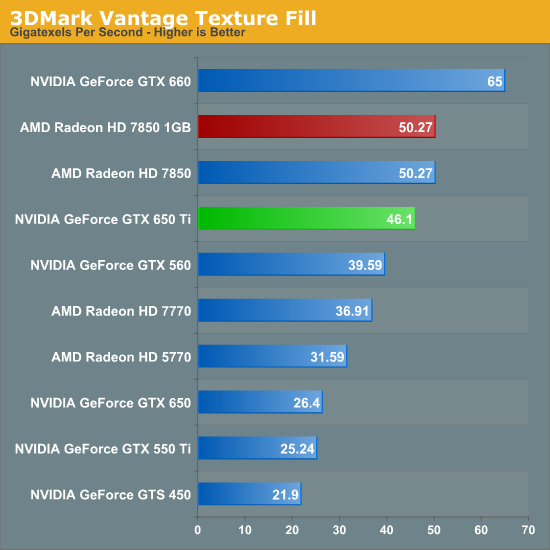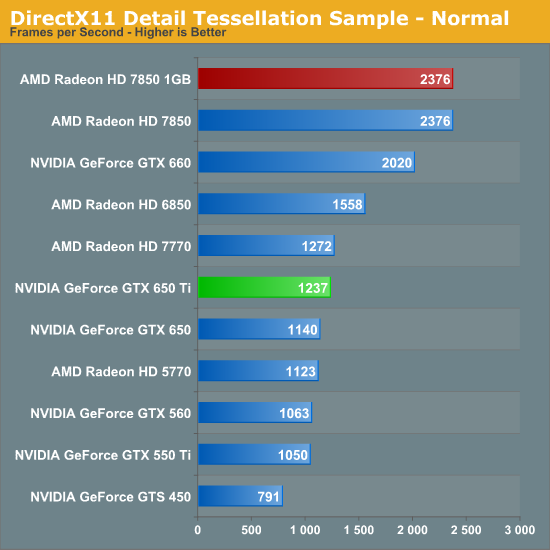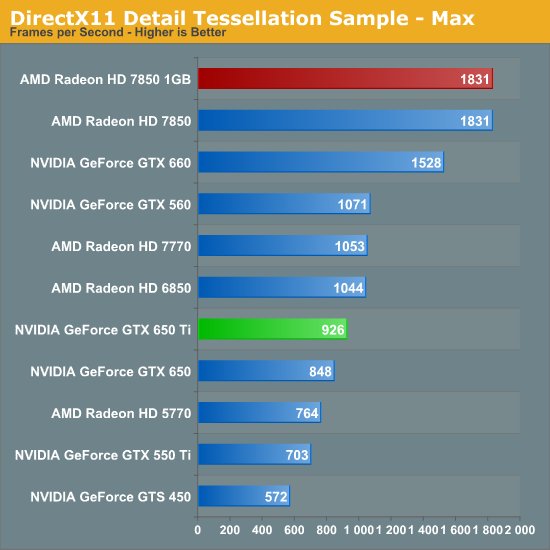The NVIDIA GeForce GTX 650 Ti Review, Feat. Gigabyte, Zotac, & EVGA
by Ryan Smith on October 9, 2012 9:00 AM ESTSynthetics
As always we’ll also take a quick look at synthetic performance to see if NVIDIA’s core configuration has had any impact on basic performance metrics. Paper specifications tell us that texture fillrate should take a decent hit with pixel fillrate takes an even larger hit; and meanwhile tessellation should hold up fairly well. We’ll start with 3DMark Vantage’s Pixel Fill test.

As expected, the GTX 650 Ti drops off a cliff compared to the GTX 660. Despite this, it does rather well compared to the GTX 650 despite the similar ROP throughput and memory bandwidth of the two cards. It can even edge out the GTX 560 in the process.

Meanwhile 3DMark Vantage’s Texture Fill test backs up our earlier texture performance expectations. The drop compared to the GTX 660 is still large, but not by nearly as much as the pixel fillrate. Having twice as many SMXes as the GTX 650 also means that it comes close to doubling the GK107 card’s performance here.
Our third theoretical test is the set of settings we use with Microsoft’s Detail Tessellation sample program out of the DX11 SDK


So much for tessellation performance holding up. This is admittedly a high pixel throughput test (we’re measuring at 1000fps+), but it’s also a very simple test that doesn’t have a great deal of overdraw. Despite the fact that the GTX 650 Ti holds on to most of GK106’s Polymorph Engines, performance drops by 40% relative to the GTX 660, which is far more in-line with the loss of ROP throughput and memory bandwidth.
Our final theoretical test is Unigine Heaven 2.5, a benchmark that straddles the line between a synthetic benchmark and a real-world benchmark as the engine is licensed but no notable DX11 games have been produced using it yet.

Despite everything else we’ve seen, Unigine results are almost exactly in the middle of the expected performance loss between shading/texturing and ROP/memory on the GTX 650 Ti. This makes it just good enough to tie the GTX 560, or surpass the GTX 550 Ti by nearly 50%.










91 Comments
View All Comments
saturn85 - Wednesday, October 10, 2012 - link
great folding@home benchmark.Tchamber - Thursday, October 11, 2012 - link
At 1920x1200 2gb doesn't make a difference... so when does the extra memory come into play? Is it a resolution thing or a matter of having the cores to drive it?Ryan Smith - Friday, October 12, 2012 - link
The extra memory is primarily for textures & buffers. Skyrim of course has its high res texture pack, and meanwhile you have deferred renderers like Battlefield 3 that create relatively large G-buffers, and larger buffers still if you want MSAA.ForeverAlone - Friday, October 12, 2012 - link
I don't really see why anyone would buy the 650.In the UK, the 6850/6870's are just a little bit more and massively outperform a 650.
CaedenV - Friday, October 12, 2012 - link
I was surprised that 1GB is really enough for most games. I figured that 2GB was overkill, but that something in the 1.2-1.5GB would show some added benefit to more games. Is there a utility that can show just how much Ram is being used by these titles so that we know how close we are to that 1GB ceiling on most games?I think with the new consoles coming out next year, having that extra Ram on the GPU will be important for people who do not upgrade often. The new consoles should push developers to add much higher resolution textures, as well as having more variety of textures for their environments, which will no doubt push cards past that 1GB mark.
maximumGPU - Saturday, October 13, 2012 - link
MSI Afterburner can show you gpu ram usage.Leyawiin - Friday, October 12, 2012 - link
Yes, I know the HD 7850 is a better value, so I'll get that out of the way. Still, the GTX 650 Ti with its tiny size, low power consumption and quiet operation would be great for a SFF project. Performs about on par with a GTX 560 and that's fine for 1080p gaming at good quality levels.bernlin2000 - Wednesday, October 24, 2012 - link
It's a bit silly, some of the analysis of these benchmarks. Frankly, any performance above 50 fps average is fantastic, and comparing cards above those numbers is pointless: they're all going to play those games well and nobody notices the difference between 60 and 120 fps. Saying that the GTX 650 Ti (which I just ordered) "doesn't fair particularly well" on Skyrim, when at 1650x1050 it's running at 88.8 fps is just madness. That's with the high resolution textures too? Talk about unnecessary criticism!ajay799 - Saturday, November 10, 2012 - link
i bought a MSI R7770-PMD1GD5 and its like almost silent in idle ... my 3.5 HDD is louder... and even under load its really quiet so i dont get these noise levels from the test besides one of my friends has a HD6850 and under load that sounds like a freaking jet absolutely terrible like my old GTX260 ... compared to the HD7770 thats like night and dayid say these measurements are way off...
Mooseparade - Saturday, June 1, 2013 - link
I bought a Galaxy GTX 650 Ti 1gb for a budget build ($129 - $20 rebate) and it won't even hit 1050mhz core clock. This thing is very dissapointing